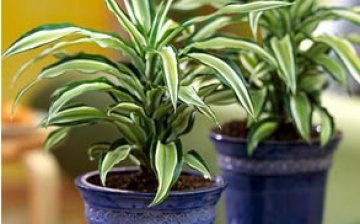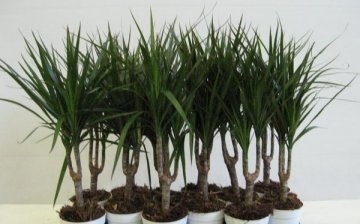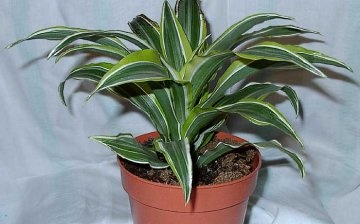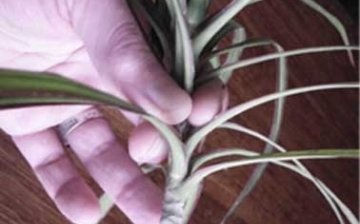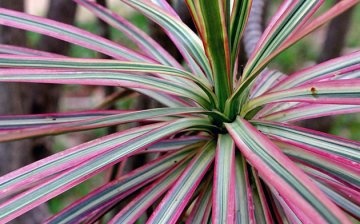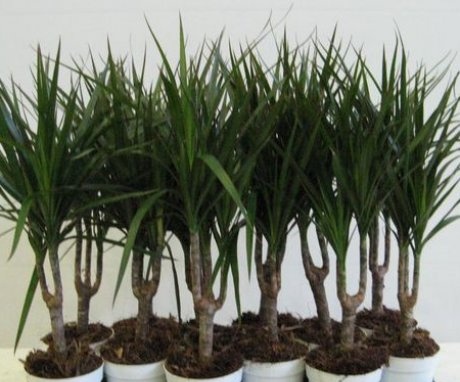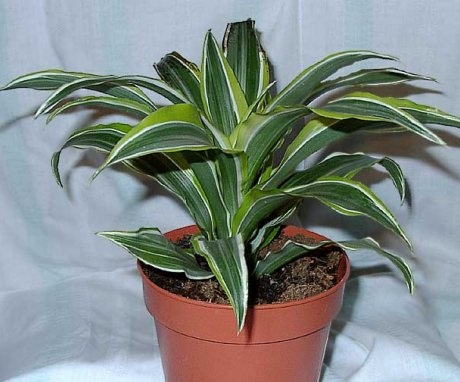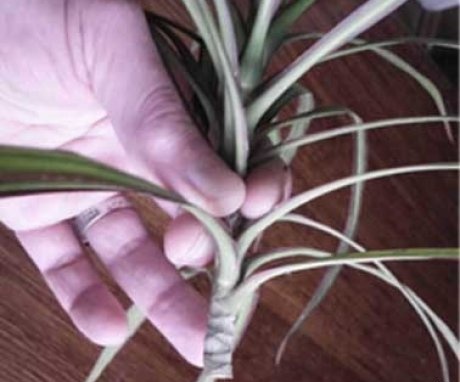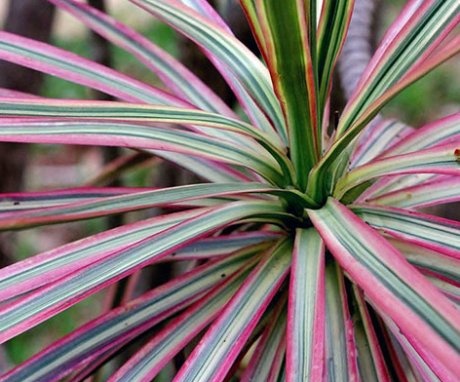Dracaena: the right soil for growing and reproduction
Dracaena is a perennial plant that belongs to the Butcher family. There are about 100 species of this plant, which are native to Africa and South Asia. Many of them can be easily grown indoors. Dracaena has thin roots and is colored yellow. Dracaena is one of the most popular indoor plants. This is due to the fact that the plant is not demanding in care, but with its decorative appearance it will decorate any room.
Content:
Dracaena species
The most popular types of dracaena:
- Dracaena marginata. One of the most popular and common types of dracaena. Perennial, at home its height can reach 3 meters. The stalks are thick and stiff over time. The leaves are long and narrow, glossy, smooth. They are mainly colored green, but there are varieties with yellow or red longitudinal stripes.
- Dracaena is fragrant. A perennial plant, reaches a height of 2 meters. Leaves are long and medium latitude. Painted in deep green with a gray longitudinal stripe. This type of dracaena blooms at home. The flowers are small, white-colored and have a pleasant fragrant aroma.
- Dracaena bordered. Perennial evergreen plant. In nature, it can grow up to 5 meters, at home it forms an ornamental tree-bush that is half the height. The leaves are narrow and long, painted mainly in green tone with a white, beige or yellowish border.
In what soil should dracaena grow
Despite the fact that almost all types of dracaena are unpretentious in care, a few simple rules should still be followed. Then the plant will be especially beautiful and lush, and will delight with its beauty for a long time.
When growing dracaena in indoor conditions, a place for it must be chosen with good lighting, without direct sunlight on the leaves.
For example, a plant can be placed on a stand that can be positioned 1.5–2 meters from a window. If dracaena is not a variegated species, it can be placed in partial shade. Artificial special lighting, which is often used when breeding plants in greenhouses, is also suitable. For the summer period, the plant is recommended to be taken out into the fresh air, balcony, terrace or summer cottage. Fresh air has a beneficial effect on plant development, the leaves become bright and fresh, the growth of the trunk increases significantly. When choosing a place for summer overexposure, you should take into account some of the nuances. The leaves are covered with burns when exposed to direct sunlight, so the plant must be placed in partial shade. You should also avoid drafts and winds, as dracaena can get sick.
Temperature range for dracaena:
- The ambient temperature around the plant should not fluctuate much.
- With a sharp drop of 10 degrees, the plant becomes ill and often this leads to death.
- Dracaena prefers medium temperatures.
- In summer, the range should be in the range of 18-25 degrees; in the cold months of the year, the thermometer should not fall below 15.
- Some types of dracaena can withstand an air temperature of +12 degrees for a long time, but there are few of them and it is not recommended to risk the health of the plant.
Dracaena feels fine in dry air. But during the heating period, it is recommended to periodically spray the leaves of the plant with warm soft water. You can also use a humidifier. Once every 1-2 months, a dracaena can be organized with a warm shower. The leaves are regularly wiped from dust so that the pores do not clog and the plant can breathe easily.
Watering dracaena:
- Watering for dracaena is one of the most important care items. The earthen lump in the pot should not dry out, but even with constant overflow, the roots of the plant quickly rot. Therefore, in a hot period, it is necessary to water the dracaena every other day, but check that the top layer of the substrate is dry by 4-5 cm.
- Water for this must be used soft, settled, room temperature.
- After watering, drain the excess water from the sump. If the dracaena species is broad-leaved, then watering should be more abundant, since more moisture evaporates through the foliage.
- In winter, the number of watering is reduced, but complete drying of the substrate is not allowed. It is recommended to periodically loosen the soil in the pot. This can be done the day after watering. This will improve the penetration of air into the soil, allowing the roots to breathe.
Dracaena is fed in the spring and summer, when it is in a state of growth. This procedure is performed once every 2 weeks. Fertilizers are selected for indoor flowers, fluoride-free. Dracaena can be trimmed if necessary. The upper shoots of young plants are mainly cut to stimulate branching. For this, a sharp knife is used, and the cut is made so that several leaves remain below it.
Early spring is good for transplanting.
Young plants, which are 1-3 years old, are transplanted every year. Those who are more than 3 years old need fresh soil 1 time in 2 years. Adults and large species of dracaena are rolled from tub to tub once every 4–5 years. During this period, you can replace the top layer of the substrate. When buying a flower, the transplant is done in 2-3 weeks. This period is being waited out so that the plant can adapt to new conditions.
Dracaena soil can be purchased at a store or made yourself. To do this, you need to take sand, sod land, humus and leafy ground. All in equal proportions, mix well and add a little charcoal.
Dracaena reproduction
The easiest and most popular way to propagate dracaena is by cuttings. For this, the tops of the shoots are suitable, and in some species you can use the entire branch for rooting, having previously cut it into pieces. Dracaena can also be propagated using seeds and air layers.
Dracaena cuttings:
- When grafting, pieces of branches or tops are prepared with a length of 10-12 cm.
- A little dried and treated with stimulating drugs.
- Next, the cuttings can be placed in water for rooting or a substrate can be prepared from sand and peat.
- The container with cuttings must be placed in a room where the ambient temperature ranges from 23 to 25 degrees.
- It is also recommended to make a greenhouse, which periodically needs to be ventilated.
- Cuttings planted in the substrate are regularly watered with soft warm water.
- After 4-5 weeks, the rooted cuttings can be planted in separate pots in a permanent place of growth.
Dracaena, which are green-leaved, are propagated with the help of seeds. Before sowing seeds are recommended to be processed means that stimulate germination. The soil is prepared from peat and sand. The container with the planted seeds is covered with foil and kept in a room where the temperature does not drop below 25 degrees. The soil is constantly ventilated and watered with soft water from a spray bottle. Seedlings should appear in a month.
To form an air layer, a strong and healthy branch is chosen.
A deep incision is made at the required distance from the main trunk, so that the knot is close. A match is placed in the incision so that it separates the parts of the branch and does not allow it to grow together. Peat is placed under and around this place, which, in turn, is covered with a bag. This bag must be kept moist at all times. You can separate the layers when the roots take up most of the package.
Plant diseases and pests
Dracaena is a rather unpretentious plant. But with improper care or selection of a growing place, the plant may be exposed to scabbard or spider mite attacks.
If the lesion is found in the initial stages, then a soap solution can be used for treatment. To do this, pots with diseased plants are placed in a bath and all the leaves are washed with soapy water by hand. In case of severe infection, special drugs are used.
In dracaena, the tips of the leaves turn yellow with a lack of moisture in the air.
This is especially true in winter when the heating is on. To do this, it is recommended to put a humidifier near the plant. The sun's rays can cause burns on the leaves. In this case, the dracaena should be moved to partial shade or to a room with diffused light. The damaged leaves are removed.
More information on the types of dracaena can be found in the video.



